 |
| ______________________________ |
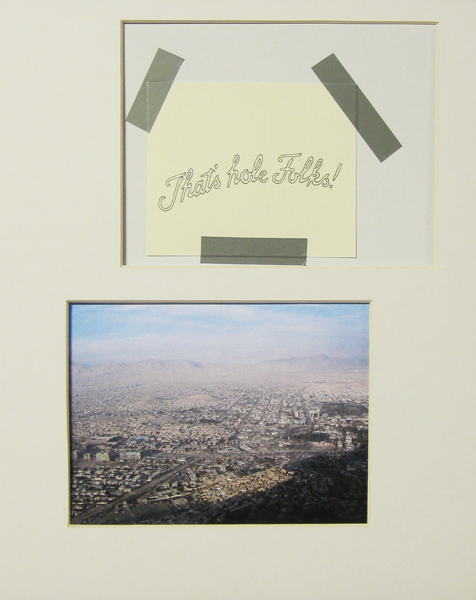 |
||
that’s hole folks!,2010 inchiostro su carta riciclata, passepartout sagomato, stampa fotografica su carta, grey tape / ink on recycled paper, shaped passe-partout, ink-jet print on paper, grey tape cm 30x35 |
||
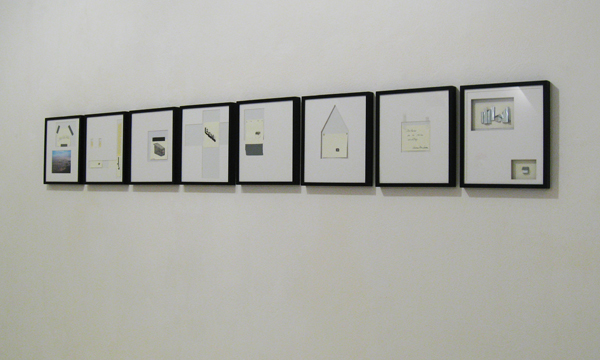 |
||
particolare di parte dell'installazione / detail from part of the installation Homework |
||
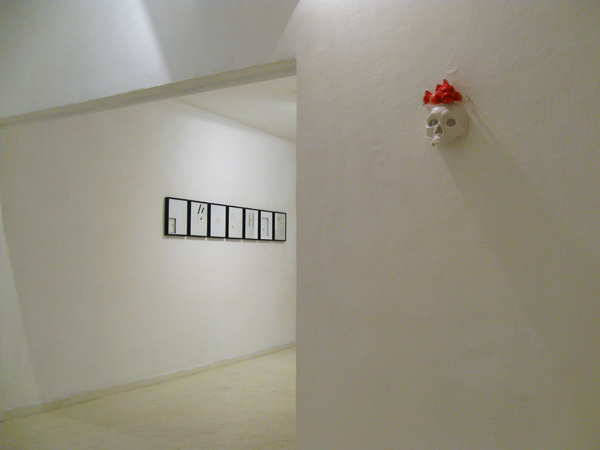 |
||
| veduta della mostra / exibition view | ||
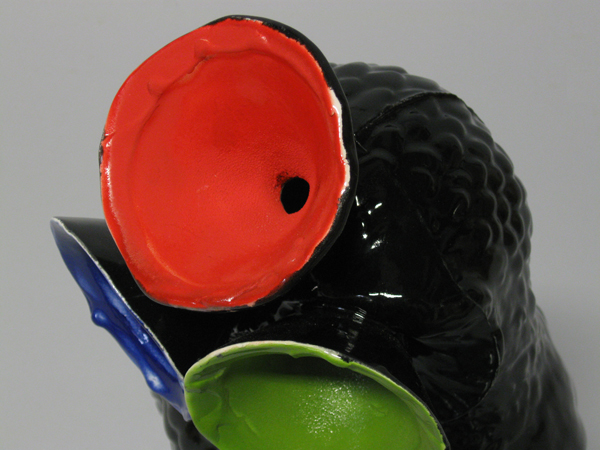 |
||
r.g.b. or life teacher since 1931, 2010 terracotta smaltata / glazed earthenware 40x23x22 cm |
||
 |
||
politics kills idol, 2010 terracotta smaltata, zampa di capriolo in tassidermia / glazed earthenware, taxidermy roe leg 38x36x19 cm |
||
 |
||
tronco di vita ovvero altare a giacinto, 2010 |
||
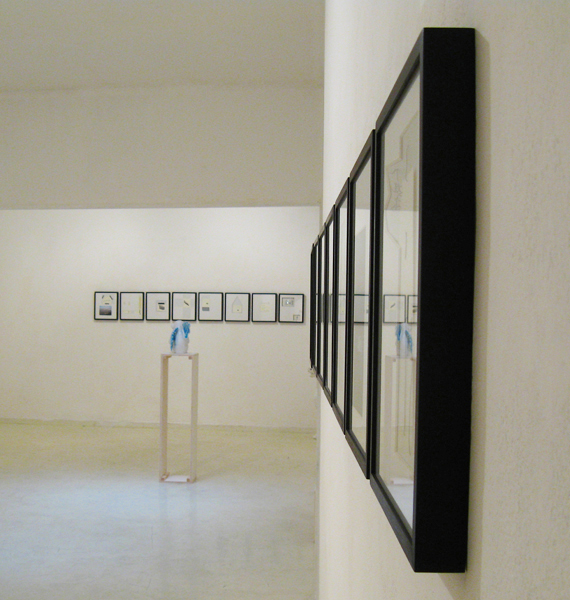 |
||
veduta della mostra / exibition view |
||
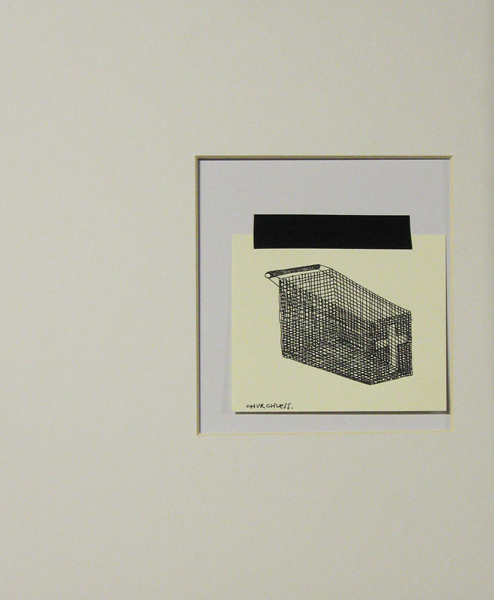 |
||
churchless, 2010 |
||
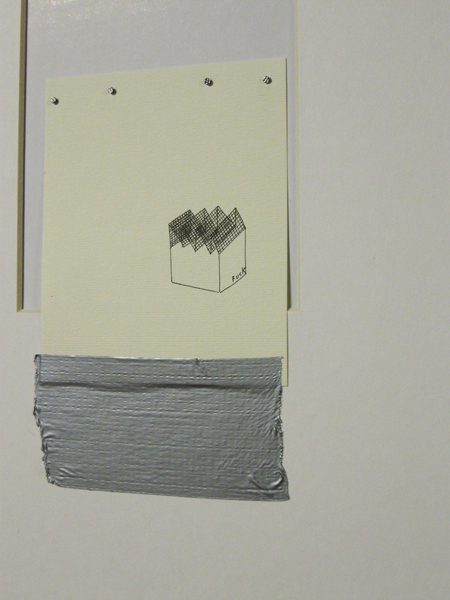 |
||
industry, 2010 |
||
 |
||
particolare di parte dell'installazione / detail from part of the installation Homework |
||
|
||
That's hole Folks!![]()
Galleria 42 / Modena
Homework parte come un’errata idea di architettura che decide di presentarsi in maniera precisa e curata, rigorosa nella sua depravata decadenza come a chiarificare i risvolti dell’odierna economia e per questo anche dell’arte contemporanea.
Da questa riflessione nascono una serie di ordinati disegni/sculture che si adagiano sotto vetro molestando il passepartout, che corrotto si pone come piattaforma descrittiva e oratore, lasciandosi coinvolgere e interagendo con lo spazio circostante.
Una serie di richiami arguti e pungenti che vanno dalla tragedia dell’11 settembre, al sesso come moneta di scambio, all’economica politica del terrore, al carrello della spesa sempre più vuoto, alla mancanza di possibilità…collegando la religione ai nuovi idoli che governano il mondo assieme al denaro…le banche!
Architetture che cercano, grazie alle leggere lamiere in alluminio, di parlare di una realtà impalpabile quanto brutale nel momento in cui ci si trova lontani dal fulcro, all’ombra del nucleo “sano”.
In questa riflessione calcolata e severa, l’artista si concentra come non mai, come se si trattasse di svolgere un lavoro o meglio il “compito a casa” che, non temendo rimpianti, dichiara di aver sempre strategicamente eluso.
Il ritmo del lavoro è dettato dalle continue disarmonie all’interno delle cornici nere, scotch di vario tipo, chiodi in ferro e terracotta fissano i disegni all’interno di passepartout sbilanciati, fuori centro e sagomati che celebrano schemi e scheletri del contemporaneo.
Nero
Homework has kicked off as a wrong architectural idea, presenting itself in an accurate, severe and kinky decadent mood as if to clarify the implications of today's economy and for that, of contemporary art as well.
From this reflection, a set of tidy drawings/sculptures was born. Those drawing are lying under the glass, almost annoying the passe-partout that stands as the descriptive platform where the surrounding space is involved and interacts.
The series recalls sharply several topics, ranging from Sept, 11th, to sex as trading currency, the economic politics of terror, the each-day-emptier trolleys, the lack of chances, binding together religion and the new idols that rule the world together with the money...the banks!
Architectures seeking, though light aluminum barriers, to talk about an intangible yet brutal truth in the very moment you are far away from the hub, under the shadow of a "healthier" core.
The artist is extremely intent in this measured and severe reflection, as if he was doing his job or homework that he claims he has always trying to strategically elude.
The rhythm in the work is determined by unbroken clashes inside the black frames, different kind of tapes, metal and clay nails anchoring the drawings inside unbalanced and shaped passe-partout, celebrating outlines and skeletons of the contemporary.
Nero
Con occhi post-reali.
Valerio Borgonuovo intervista Nero/Alessandro Neretti
Cos'è per te il nero?
Il nero (è un colore che) aiuta la forma a liberarsi da ulteriori colori. Feroce, estremo, superbo, essenziale…
Cos'è per te il bianco?
Il bianco (è un colore che) aiuta la forma a liberarsi da ulteriori colori. Poetico, alto, candido, vitale…
Cos’è per te la scultura?
Per me la scultura è qualcosa di serio. Linea, spazio e materia. Mi baso molto sui canoni tradizionali della storia dell’arte e del gusto per poi rielaborare autonomamente ogni elemento secondo personale volontà, fare “il diavolo a quattro”, tagliare, violare, bere duro, spifferare false verità, sbottare, nascondere, mescolare, guardare dentro, fottere, tutto quello di cui ho voglia e che detta il mio pensiero. Lascio che i miei lavori vivano lo spazio e che quest’ultimo viva grazie ad essi, marcato e scolpito dalla loro presenza. Che sostengano il ruolo della vita.
Cos'è per te la ceramica?
La ceramica, o meglio la terracotta smaltata, è a mio avviso un materiale terribile e angosciante. Non dà possibilità di errore, la sua fragilità è estrema ed è stata per secoli rilegata nella cerchia delle cosiddette arti minori...dove ancora per molti si trova. Fondamentalmente è un mezzo che aiuta a sostenere parte del mio lavoro e per questo della mia vita. Odio e calore.
Dove vivi?
Sopravvivo principalmente a Faenza. Dove vago come un homeless ‘ceramico’ tra la Bottega Gatti e il mio studio.
Cos'è per te il kitsch?
Sicuramente se parliamo di mobilia che arreda e decora, la terracotta smaltata rimane a mio avviso uno dei materiali più atroci che sia mai stato impiegato con una certa frequenza negli ultimi quaranta, cinquanta anni. Per atroce in questo caso intendo quasi scellerato, senza il benché minimo rispetto di determinati parametri estetici e con la completa sfrontatezza espositiva. Ma che entra nel cuore e non se ne può più fare a meno.
Come nasce All you can eat or live?
Questo ciclo di lavori, esploso alla fine del 2007, ha avuto il suo incipit nel dicembre del 1998 in una discarica di Pantelleria durante un viaggio estremo e visionario. Lì, nel mezzo di tutto, ho incontrato i frammenti di una testa di dalmata in ceramica dalla fattura approssimativamente realistica che (come spesso mi capita di fare con molte altre cose) ho raccolto e conservato. In quel momento ho realizzato che tutto ciò che pensavo sul kitsch e sull’osceno mondo di cani grotteschi potesse essere a tempo debito e in seguito ad una rielaborazione scrupolosa usato (letteralmente) per fare arte.
Cosa tratta?
Questo ciclo di lavori affronta innanzitutto le possibili declinazioni poetiche e non dell’essere umano, i suoi comportamenti pubblici e privati, le dinamiche interelazionali entro cui si trova ad agire e ad operare, le sue mutazioni/ibridazioni sociali. Per questa e per altre ragioni ancora rappresenta e rispecchia anche il mio rapporto col “tutto”, con la storia, la religione, la mitologia. Animali dagli occhi umani che sembrano parlare di mille cose…mille cose da lobotomia, da cocaina, da omicidio colposo, da “sono appena scappato”, da “non mi picchiare!”
Perché That’s hole folks?
Saccheggiare e devastare sembra la prerogativa con la quale modificare quelle che potrebbero essere gestite come delle operazioni economiche e sociali. Questo lavoro nasce da un gioco con la famosa frase (That’s all Folks) che concludeva una nota serie di cartoni animati americani. That’s hole Folks! affronta il tema degli interessi economici che portano le grandi nazioni a trasformare i loro obbiettivi in veri e propri buchi.
Per rimanere in tema, cosa dicono gli occhi?
Gli occhi minacciano. Gli occhi supplicano. Gli occhi sono buchi. Gli occhi possono essere maliziosi. Gli occhi smascherano. Gli occhi piangono. Gli occhi squadrano. Gli occhi socchiusi sotto i raggi di sole. Gli occhi stupiti. Gli occhi furbi e scaltri. Gli occhi sono occhi e spesso ci trovi una pagliuzza.
Cos'è il reale?
Il reale esiste e si conserva solo grazie all’enorme potenza dell’irreale. Ciò che è onirico e che risiede in noi sotto forma di carica inerte nasconde una potenzialità inaspettata. Nella vita amo infinitamente falsificare il reale tramite azioni e racconti surreali che corrispondono al vero, che descrivono ciò che accade attorno a me e che per l’assurda follia di cui si compongono diventano post-reali.
Cos'è l'icona?
L’icona è il simbolo. Il simbolo è il messaggio. Il messaggio è il richiamo. Il richiamo è l’icona.
Cos’è il male?
Mi capita di essere rapito dal male. Mi capita di accorgermene. Mi capita di pentirmene. Mi capita di ricaderci ogni qualvolta non sono chiaro con la mia anima.
Cos’è la truffa?
Mettere in atto una manovra tesa a raggirare un singolo o una serie di individui può richiedere non solo un piano ben congeniato ma anche una dose di fortuna. Nel caso invece di voler truffare un pubblico più vasto quello dell’arte contemporanea la condizione dell’individuo è che deve essere pronto a coinvolgere la sua intera vita oppure avere una grossa fortuna.
Quante mosche metti nella Sambuca?
Mosche nella Sambuca? Ne voglio almeno sette!!!
With a post-real eye.
Valerio Borgonuovo interviews Nero/Alessandro Neretti
What is black to you?
Black (is a color that) helps shapes to get rid of further colors. Fierce, extreme, proud, essential…
What is white to you?
White (is a color that) helps shapes to get rid of further colors. Sublime, high, spotless, vital…
What is sculpture to you?
Sculpture is to me something important. Lines, space and matter. I do rely a lot on the traditional canons of the history of arts to process each element of my work autonomously. Raising the hell, cutting, breaching, drinking hard, spilling out fake truths, bursting out, hiding, mixing, looking inside, fucking, doing every thing I want and everything my mind orders me to do... I let my works living the space and the space living through my works, branded and shaped by their presence. I let them bearing the role of life.
What is ceramics to you?
Ceramics, or better enameled clay, is to me a frightening and distressful material. It doesn’t leave any margin for error, it is extremely fragile and for centuries has been considered as a minor art, which is still happens to some extent today. It is basically a mean to sustain part of my job and for that part of my life as well. Hate and heat.
Where are you living?
I survive mainly in Faenza. There, I do wonder as a pottery homeless between Bottega Gatti and my studio.
What is kitsch to you?
If we are talking about furniture, enameled clay is for sure the most raging material being used so frequently in the last forty, fifty years. As I say raging in this case, I mean wicked almost, as it does not have the meanest respect of a certain set of aesthetic parameters and the worst explosive cheekiness too. After all however, it steals into your heart and then you can't help living without it.
How did All you can eat or live originate?
This cycle of works, exploded at the end of 2007, originated in December 1998 in a dump in Pantelleria during an extreme and visionary trip. There, in the middle of everything, I stumbled across the fragments of a clay head of a Dalmatian dog. It was so lifelike that, as it often happens to me with many other things, I picked it up and kept. In that very moment, I understood that everything I thought about the kitsch and obscene world of grotesque dogs could be used (literally) to make art.
What is this cycle about?
This cycle of works explores the possible poetic (and not) declinations of the human being, their public and private behaviors, the interrelation dynamics where they act and function, their social mutation/hybridizing. For this and many other reasons more, this work also represents and reflects my relationship to the ‘whole’, to history, religion and mythology. Animals with human eyes that talk about a million things…a thousand things. They scream lobotomy, cocaine, murder, ‘I just flew away’, ‘don’t beat me!’
Why That’s hole folks?
Because transactions theoretically social and economic are often resolved with looting and devastation. This work was born as a wordplay with the well-known close up sentence (That’s all Folks) of American cartoons. That’s hole Folks! handles the theme of economic interests leading the greater nations to transform their aims in true holes.
To stick to the topic, what are the eyes telling?
Eyes are threatening. Eyes are begging. Eyes are holes. Eyes can be cunning. Eyes can be revealing. Eyes are crying. Eyes are peering. Slit eyes under sunrays. Dazed eyes. Cunning eyes. Eyes are eyes and you often find a mote.
What is real?
Real exists and is preserved by the huge power of the unreal. The dream element living in everyone under the form of idle charge is hiding an unexpected potential. In life, I love to forge the real through unreal yet truthful actions and tales that describe what is happening around me and almost become post-real being originated out of incongruous madness.
What is the icon?
The icon is the symbol. The symbol is the message. The message is the recall. The recall is the icon.
What is the evil?
I sometimes happen to be intrigued by the evil. I also happen to realize that. I happen to regret that. I happen to slip back into it every time I am not honest to my soul.
What is fraud?
To manoeuvre against a single person or a group of persons might demand not only a well thought plan but also a touch of luck. If you are to cheat on a wider audience then, the condition of the individual is that of betting their entire life or instead having a huge luck.
How many coffee beans you want in your Sambuca?
Coffee beans in my Sambuca? At least seven!!!